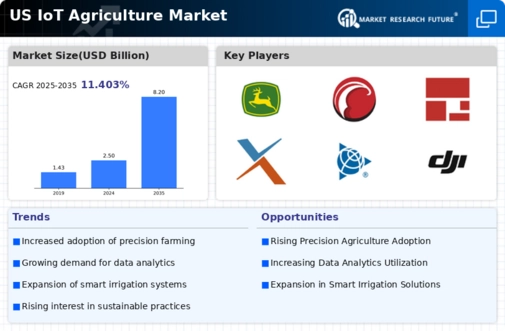The competitive landscape of the US IoT Agriculture Market is characterized by rapid technological advancements and a focus on optimizing agricultural productivity through connected devices and data analysis. This market is highly dynamic, with companies leveraging IoT solutions to address various agriculture challenges including resource management, crop monitoring, and environmental sustainability.
The increasing adoption of smart farming practices is fostering competition among various players who seek to provide innovative solutions that cater to the evolving needs of farmers. Key players are undergoing strategic partnerships, mergers, and acquisitions to expand their market share and enhance their technological capabilities, ultimately leading to high levels of innovation and customer engagement.John Deere stands out in the US IoT Agriculture Market due to its expansive product portfolio and longstanding reputation in the agricultural sector.
The company's commitment to integrating IoT technologies into its machinery has resulted in advanced solutions that empower farmers to make informed decisions based on real-time data. John Deere's strengths lie in its established distribution channels, strong brand recognition, and substantial investments in research and development.
The company's precision agriculture tools not only enhance operational efficiency but also promote sustainable practices, giving it a competitive edge in delivering value-added services to its customers. Moreover, John Deere has ventured into collaborative initiatives and alliances, contributing to its robustness in an increasingly competitive market.PrecisionHawk has carved a niche for itself in the US IoT Agriculture Market by specializing in advanced drone technology and data analytics. The company offers key services that help farmers in crop health monitoring, field mapping, and yield estimation, thus facilitating precision agriculture practices.
PrecisionHawk’s strengths are highlighted by its innovative use of aerial technology combined with analytical tools, allowing for insightful data collection that aids farmers in maximizing yields while minimizing costs. With notable market presence, PrecisionHawk has also engaged in partnerships and acquisitions to bolster its capabilities and extend its footprint in the agricultural sector. Their focus on integrating artificial intelligence with agricultural data enhances their service offerings, making them a formidable player in the US agricultural landscape.



















